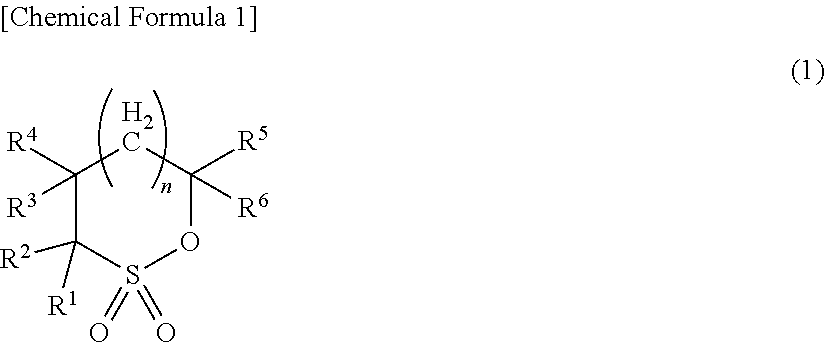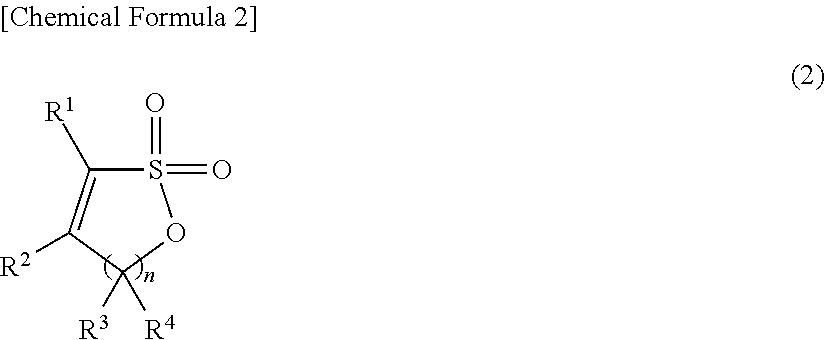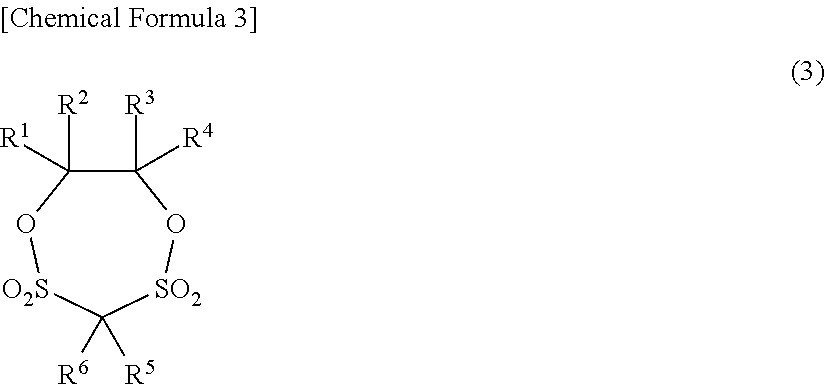Nonaqueous lithium-type power storage element
a power storage element and non-aqueous technology, applied in cell components, electrochemical generators, transportation and packaging, etc., can solve the problems of insufficient effect, no effect of improving durability at high temperature, and no effect of improving properties, so as to improve durability, reduce gas generated, and improve the effect of durability
- Summary
- Abstract
- Description
- Claims
- Application Information
AI Technical Summary
Benefits of technology
Problems solved by technology
Method used
Image
Examples
example 1
[Preparation of Electrolyte]
[0389]As an organic solvent there was used a mixed solvent of ethylene carbonate (EC):methyl ethyl carbonate (EMC)=33:67 (volume ratio), each electrolyte salt was dissolved so that the concentration ratio of LiN(SO2F)2 and LiPF6 was 25:75 (molar ratio) with respect to the total electrolyte and the total concentration of LiN(SO2F)2 and LiPF6 was 1.2 mol / L, and the obtained solution was used as a nonaqueous electrolyte.
[0390]The concentrations of LiN(SO2F)2 and LiPF6 in the prepared electrolyte were 0.3 mol / L and 0.9 mol / L, respectively.
[Assembly and Performance of Power Storage Element]
[0391]Positive electrode body A and negative electrode body A were each cut to 100 mm×100 mm, a one-sided positive electrode body A was used for each of the uppermost side and lowermost side, and using 18 double-sided negative electrode body A components and 17 double-sided positive electrode body A components, a polyolefin porous film separator with a thickness of 15 μm was...
example 53
[Preparation of Electrolyte]
[0410]As an organic solvent there was used a mixed solvent solution of propylene carbonate (PC):methyl ethyl carbonate (EMC)=97.5:2.5 (volume ratio), each electrolyte salt was dissolved so that the concentration ratio of LiN(SO2F)2 and LiPF6 was 25:75 (molar ratio) with respect to the total electrolyte and the total concentration of LiN(SO2F)2 and LiPF6 was 1.2 mol / L, and the obtained solution was used as a nonaqueous electrolyte.
[0411]The concentrations of LiN(SO2F)2 and LiPF6 in the prepared electrolyte were 0.3 mol / L and 0.9 mol / L, respectively. The flash point of the nonaqueous electrolyte was measured by the Tag closed-cup method specified by JIS K 2265-1-2007, and was found to be 80° C. or higher and below 90° C.
[Assembly and Performance of Power Storage Element]
[0412]Positive electrode body A and negative electrode body A were each cut to 100 mm×100 mm, a one-sided positive electrode body A was used for each of the uppermost side and lowermost side...
PUM
| Property | Measurement | Unit |
|---|---|---|
| flash point | aaaaa | aaaaa |
| thickness | aaaaa | aaaaa |
| thickness | aaaaa | aaaaa |
Abstract
Description
Claims
Application Information
 Login to View More
Login to View More - R&D
- Intellectual Property
- Life Sciences
- Materials
- Tech Scout
- Unparalleled Data Quality
- Higher Quality Content
- 60% Fewer Hallucinations
Browse by: Latest US Patents, China's latest patents, Technical Efficacy Thesaurus, Application Domain, Technology Topic, Popular Technical Reports.
© 2025 PatSnap. All rights reserved.Legal|Privacy policy|Modern Slavery Act Transparency Statement|Sitemap|About US| Contact US: help@patsnap.com



